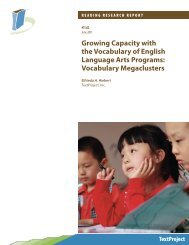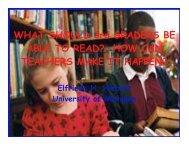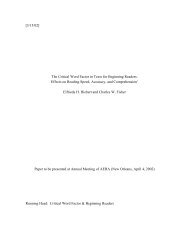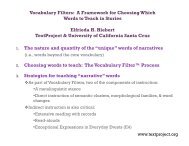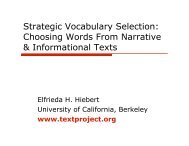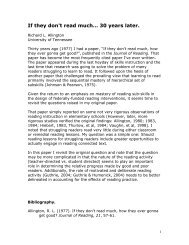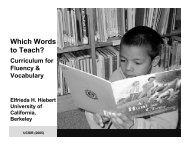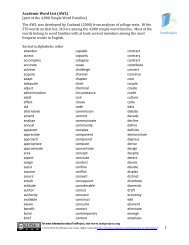Aligning Theory and Assessment of Reading Fluency - Wiley Online ...
Aligning Theory and Assessment of Reading Fluency - Wiley Online ...
Aligning Theory and Assessment of Reading Fluency - Wiley Online ...
Create successful ePaper yourself
Turn your PDF publications into a flip-book with our unique Google optimized e-Paper software.
Kelly, M.H., & Bock, J.K. (1988). Stress in time. Journal <strong>of</strong>Experimental Psychology. Human Perception <strong>and</strong> Performance, 14(3),389–403. doi:10.1037/0096-1523.14.3.389Kerkh<strong>of</strong>s, R., Vonk, W., Schriefers, H., & Chwilla, D.J. (2008).Sentence processing in the visual <strong>and</strong> auditory modality: Do comma<strong>and</strong> prosodic break have parallel functions? Brain Research,1224, 102–118. doi:10.1016/j.brainres.2008.05.034Klauda, S.L., & Guthrie, J.T. (2008). Relationships <strong>of</strong> threecomponents <strong>of</strong> reading f luency to reading comprehension.Journal <strong>of</strong> Educational Psychology, 100(2), 310–321.doi:10.1037/0022-0663.100.2.310Kleiman, G.M., Winograd, P.N., & Humphrey, M.M. (1979). Prosody<strong>and</strong> children’s parsing <strong>of</strong> sentences (Tech. Rep. No. 123). Champaign,IL: Center for the Study <strong>of</strong> <strong>Reading</strong>.Koriat, A., Greenberg, S.N., & Kreiner, H. (2002). The extraction<strong>of</strong> structure during reading: Evidence from reading prosody.Memory & Cognition, 30(2), 270–280.Krivokapić, J. (2007). Prosodic planning: Effects <strong>of</strong> phrasal length<strong>and</strong> complexity on pause duration. Journal <strong>of</strong> Phonetics, 35(2),162–179. doi:10.1016/j.wocn.2006.04.001Kuhn, M.R. (2005). A comparative study <strong>of</strong> small group fluencyinstruction. <strong>Reading</strong> Psycholog y, 26(2), 127–146.doi:10.1080/02702710590930492Kuhn, M.R. (2007). Effective oral reading assessment (or why roundrobin reading doesn’t cut it). In J.R. Paratore & R.L. McCormack(Eds.), Classroom literacy assessment: Making sense <strong>of</strong> what studentsknow <strong>and</strong> do (pp. 101–112). New York: Guilford.Kuhn, M.R., Schwanenflugel, P.J., Morris, R.D., Morrow, L.M., Woo,D., Meisinger, B., et al. (2006). Teaching children to become fluent<strong>and</strong> automatic readers. Journal <strong>of</strong> Literacy Research, 38(4), 357–387. doi:10.1207/s15548430jlr3804_1Kuhn, M.R., & Stahl, S.A. (2003). <strong>Fluency</strong>: A review <strong>of</strong> developmental<strong>and</strong> remedial practices. Journal <strong>of</strong> Educational Psychology, 95(1),3–21. doi:10.1037/0022-0663.95.1.3LaBerge, D., & Samuels, S.J. (1974). Toward a theory <strong>of</strong> automaticinformation processing in reading. Cognitive Psychology, 6(2),293–323. doi:10.1016/0010-0285(74)90015-2Ladd, D.R. (1984). Declination: A review <strong>and</strong> some hypotheses.Phonology Yearbook, 1, 53–74. doi:10.1017/S0952675700000294Levy, B.A. (2001). Moving the bottom: Improving reading fluency.In M. Wolf (Ed.), Dyslexia, fluency, <strong>and</strong> the brain (pp. 357–379).Timonium, MD: York.Logan, G.D. (1988). Toward an instance theory <strong>of</strong> automatization.Psychological Review, 95(4), 492–527. doi:10.1037/0033-295X.95.4.492Logan, G.D. (1992). Shapes <strong>of</strong> reaction-time distributions <strong>and</strong>shapes <strong>of</strong> learning curves: A test <strong>of</strong> the instance theory <strong>of</strong> automaticity.Journal <strong>of</strong> Experimental Psychology. Learning, Memory, <strong>and</strong>Cognition, 18(5), 883–914. doi:10.1037/0278-7393.18.5.883Logan, G.D. (1997). Automaticity <strong>and</strong> reading: Perspectives from theinstance theory <strong>of</strong> automatization. <strong>Reading</strong> & Writing Quarterly,13(2), 123–146. doi:10.1080/1057356970130203Logan, G.D., Taylor, S.E., & Etherton, J.L. (1999). Attention <strong>and</strong>automaticity: Toward a theoretical integration. PsychologicalResearch, 62(2–3), 165–181. doi:10.1007/s004260050049Madelaine, A., & Wheldall, K. (1999). Curriculum-based measurement<strong>of</strong> reading: A critical review. International Journal<strong>of</strong> Disability, Development <strong>and</strong> Education, 46(1), 71– 85.doi:10.1080/103491299100731Madelaine, A., & Wheldall, K. (2004). Curriculum-based measurement<strong>of</strong> reading: Recent advances. International Journal <strong>of</strong>Disability Development <strong>and</strong> Education, 51(1), 57–82. doi:10.1080/1034912042000182201Mathson, D.V., Allington, R.L., & Solic, K.L. (2006). Hijackingfluency <strong>and</strong> instructionally informative assessments. In T.Rasinski, C. Blachowicz, & K. Lems (Eds.), <strong>Fluency</strong> instruction:Research-based best practices (pp. 106–119). New York: Guilford.McCallum, R.S., Sharp, S., Bell, S.M., & George, T. (2004). Silentversus oral reading comprehension <strong>and</strong> efficiency. Psychology inthe Schools, 41(2), 241–246. doi:10.1002/pits.10152McKenna, M.C., & Picard, M.C. (2006). Revisiting the role <strong>of</strong> miscueanalysis in effective teaching. The <strong>Reading</strong> Teacher, 60(4), 378–380. doi:10.1598/RT.60.4.8McKenna, M.C., & Stahl, S.A. (2003). <strong>Assessment</strong> for reading instruction.New York: Guilford.Meisinger, E.B., & Bradley, B.A. (2008). Classroom practicesfor supporting fluency development. In M.R. Kuhn & P.J.Schwanenflugel (Eds.), <strong>Fluency</strong> in the classroom (pp. 36–54). NewYork: Guilford.Meisinger, E.B., Bradley, B.A., Schwanenflugel, P.J., & Kuhn, M. (inpress). Teachers’ perceptions <strong>of</strong> word callers <strong>and</strong> related literacyconcepts. School Psychology Review.Meisinger, E.B., Bradley, B.A., Schwanenflugel, P.J., Kuhn, M., &Morris, R. (2009). Myth <strong>and</strong> reality <strong>of</strong> the word caller: The relationshipbetween teacher nominations <strong>and</strong> prevalence amongelementary school children. School Psychology Quarterly, 24,147–159.Miller, J., & Schwanenflugel, P.J. (2006). Prosody <strong>of</strong> syntacticallycomplex sentences in the oral reading <strong>of</strong> young children.Journal <strong>of</strong> Educational Psychology, 98(4), 839–853. doi:10.1037/0022-0663.98.4.839Miller, J., & Schwanenflugel, P.J. (2008). A longitudinal study <strong>of</strong>the development <strong>of</strong> reading prosody as a dimension <strong>of</strong> oral readingfluency in early elementary school children. <strong>Reading</strong> ResearchQuarterly, 43(4), 336–354. doi:10.1598/RRQ.43.4.2Mokhtari, K., & Thompson, H.B. (2006). How problems <strong>of</strong> readingfluency <strong>and</strong> comprehension are related to difficulties in syntacticawareness skills among fifth graders. <strong>Reading</strong> Research <strong>and</strong>Instruction, 46(1), 73–94.Mostow, J., & Beck, J. (2005, June). Micro-analysis <strong>of</strong> fluency gains ina reading tutor that listens. Paper presented at the Society for theScientific Study <strong>of</strong> <strong>Reading</strong>, Toronto, Canada.Mostow, J., & Duong, M. (2009, July). Automated assessment <strong>of</strong> oralreading expressiveness. Proceedings <strong>of</strong> the 14th InternationalConference on Artificial Intelligence in Education, Brighton,Engl<strong>and</strong>.National Institute <strong>of</strong> Child Health <strong>and</strong> Human Development. (2000).Report <strong>of</strong> the National <strong>Reading</strong> Panel. Teaching children to read: Anevidence-based assessment <strong>of</strong> the scientific research literature on reading<strong>and</strong> its implications for reading instruction (NIH Publication No.00-4769). Washington, DC: U.S. Government Printing Office.Noordman, L., Dassen, I., Swerts, M., & Terken, J. (1999). Prosodicmarkers <strong>of</strong> text structure. In K. van Hoek, A. Kibrik, & L.Noordman (Eds.), Discourse studies in cognitive linguistics: Selectedpapers from the 5th International Cognitive Linguistics Conference(pp. 133–148). Amsterdam: John Benjamins.O’Shea, L.J., Sindelar, P.T., & O’Shea, D. (1987). The effects <strong>of</strong> repeatedreadings <strong>and</strong> attentional cues on the reading fluency <strong>and</strong>comprehension <strong>of</strong> learning disabled readers. Learning DisabilitiesResearch, 2(2), 103–109.Orsolini, M., Fanari, R., Tosi, V., de Nigris, B., & Carrier, R. (2006).From phonological recoding to lexical reading: A longitudinalstudy on reading development in Italian. Language <strong>and</strong> CognitiveProcesses, 21(5), 576–607. doi:10.1080/01690960500139355Paris, S.G. (2005). Reinterpreting the development <strong>of</strong> readingskills. <strong>Reading</strong> Research Quarterly, 40(2), 184–202. doi:10.1598/RRQ.40.2.3Paris, S.G. (2008, December). Constrained skills—so what? OscarCausey address presented at the National <strong>Reading</strong> Conference,Orl<strong>and</strong>o, FL.248<strong>Reading</strong> Research Quarterly • 45(2)





